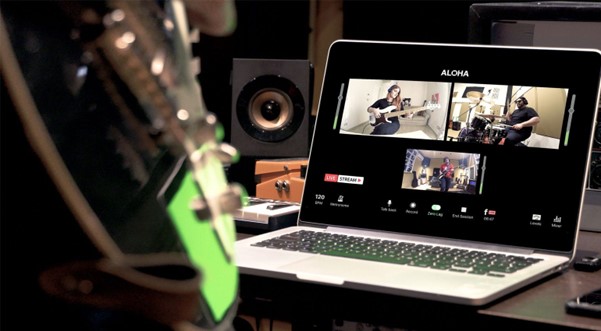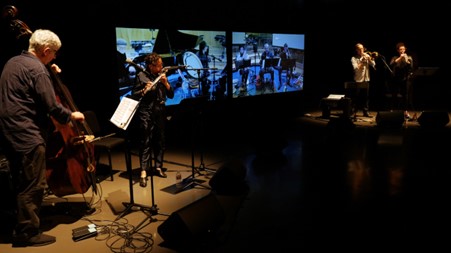The impact and importance of network-based musical collaboration (in the post-covid world)

Collaborative music-making is a core aspect of human musicality (Small, 1998). Traditionally, collaborative music making has predominantly been face-to-face, synchronous and interactive, with reliance on recording and production technologies for dissemination and archiving. However, the emergence of electroacoustic synthesis and processing, along with interactive digital systems, has brought new technologies to the forefront of music practices. New genres such as electronic music and live coding, which alongside with the rapid development of the network-based telecommunication applications, that have made it much easier to communicate and collaborate efficiently with anyone around the world, have changed the shape of music making and collaborative music creation. The Covid-19 pandemic offered a unique opportunity (and necessity) to focus on the creative usage (and further development) of these technological tools for professional and semi-professional music-makers alike.
Traditional music configurations such as orchestras, chamber ensembles, bands, etc., have been most affected due to the curtailment of coordinated simultaneous synchronous music performance. During the time of lockdown and social distancing, spaces of music production (e.g., rehearsal spaces, studios) and consumption (e.g., venues, nightclubs) had suddenly become unfit for their intended purposes. In their place, alternative approaches to music-making that prioritize accessibility and the use of technologies for remote musical interactions, such as the ubiquitous music making or ubimus community, thrived. Some musicians have also adapted their use of technology or have introduced new technological aspects to their creative and collaborative practice.
Many network musical performance softwares such as LoLa, Jamulus and JamKazam, that enable real-time rehearsing, jamming and performing with musicians at remote locations, overcoming latency, saw a huge growth. They were further developed during the pandemic, in order to provide users with more features such as: having more uncompressed audio channels to allow for full surround sound and support larger groups, such as choirs with as many as 98 members etc. In April 2020 Jamulus was being downloaded two thousand times per day, with the trend increasing. LoLa has been used for live streaming by many individual professional musicians, as well as international concerts, while the famous violist and conductor Pinchas Zukerman described it as “the savior of the profession”. Furthermore, in 2020 JamKazam managed to raise over $100,000 through crowdfunding on GoFundMe.

Nevertheless, although streaming and network-based musical collaboration have contributed towards the survival of live music during the pandemic, the revenue levels from live streaming and Video-on-Demand (VOD) work have not matched the earnings from live performances for most musicians. In the long term however, stakeholders note that it is unlikely that the core value chain of the music industry will change too dramatically. It is therefore expected that the previous operating model whereby artists and labels retain close links to streaming platforms, venue operators and event promoters to distribute music, will remain dominant following the pandemic.
Still, it is undeniable that in the post-covid world we are gifted to use to our advantage and convenience the latest applications and software, alongside with the experience that this period provided us with, as a shortcut to any sort of limitation that we may be faced with because of an inability to get in face-to-face touch with other musicians. It is now more apparent than ever, that we can musically collaborate with everyone from the comfort of our home.
References
[1] Cai, C. J., and Terry, M. (2020). “On the making and breaking of social music improvisation during the covid-19 pandemic”, in NFW ‘20 Symposium on the New Future of Work.
[2] Lemaire, E. C. (2020). Extraordinary times call for extraordinary measures: the use of music to communicate public health recommendations against the spread of COVID-19. Can. J. Publ. Health 111, 477–479. doi: 10.17269/s41997-020-00379-2
[3] Parsons, C. (2020). Music and the internet in the age of COVID-19. Early Music 48, 403–405. doi: 10.1093/em/caaa045
[4] Taylor, I. A., Raine, S., and Hamilton, C. (2020). COVID-19 and the UK live music industry: a crisis of spatial materiality. J. Media Art Study Theory 1, 219–241.
[5] “Jamulus - Internet Jam Session Software / Discussion / Jamulus Software: Audio Latency in Windows Vista”. sourceforge.net. 13 June 2006.
[6] Prince, Andy (12 March 2014). “JamKazam Lets Musicians Play Together from Different Locations”.
[7] Rosen, Peter (2020-11-15). “Social Distancing For Musicians: A Quick Guide To Low-Latency Audio”.
[8] “LoLa, Low Latency Audio Visual Streaming System Installation & User’s Manual, Version 2.0.0 (rev.001)”. Conservatorio di musica G. Tartini – Trieste, Italy.
[9] ‘Collaborating in Isolation: Assessing the Effects of the Covid-19 Pandemic on Patterns of Collaborative Behavior Among Working Musicians’. Noah R. Fram, Visda Goudarzi, Hiroko Terasawa and Jonathan Berger. Center for Computer Research in Music and Acoustics, Music Department, Stanford University, Stanford, CA, United States, Department of Audio Arts and Acoustics, Columbia College Chicago, Chicago, IL, United States, Faculty of Library, Information and Media Science, University of Tsukuba, Tsukuba, Japan 2021.
[10] The impact of the COVID-19 pandemic on cultural and creative industries. Marilena Vecco, Martin Clarke, Paul Vroonhof, Eveline de Weerd, Ena Ivkovic, Sofia Minichova, Miriam Nazarejova. Panteia 2022.
